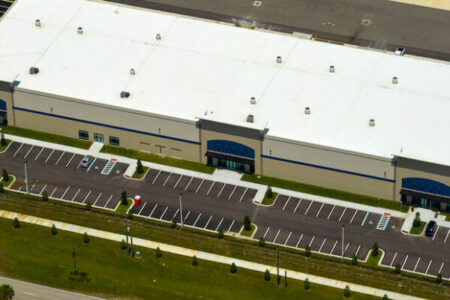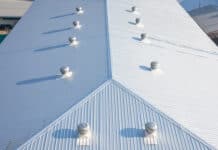
By Matt Michalski
For many years, architects, engineers, and contractors believed that a roof’s color, especially the choice between black and white, significantly impacted a building’s environmental footprint by influencing the urban heat island (UHI) effect. UHI is a phenomenon where urban areas are warmer than nearby rural areas due to human activities and changes in the natural environment, such as deforestation and the construction of buildings, roads, and other infrastructure. The simple logic is white or “cool” roofs are reflective, absorb less heat, and help to mitigate the UHI effect. Conversely, many believe that black roofs exacerbate the UHI effect by absorbing more sunlight, thus raising the building’s ambient temperature, particularly in densely populated cities. This thinking led many to choose white roofs over black roofs, and it has even led some jurisdictions to mandate specific roof colors to combat the UHI effect.
However, recent studies by the EPDM Roofing Association (ERA) have challenged this belief, finding no discernible correlation or significant impact between roof color and the UHI effect. The studies highlight building insulation technology as a more influential factor in combating the UHI effect. This shift in understanding emphasizes the importance of leveraging subject matter experts in decisions regarding commercial roofing materials and colors. Roofing professionals such as architects, consultants, and engineers bring specialized expertise in these areas to provide recommendations that best suit a building’s unique requirements.
New Insights Challenge Established Roof Color Paradigms
As communities across the nation grapple with escalating urban temperatures, some local municipalities and jurisdictions have mandated the color of roofs based on long-standing assumptions now brought into question by recent findings. The ERA research underscores that the impact of roof color on the UHI effect remains inconclusive, signaling a need for further exploration.
A critical revelation from the research points toward insulation playing a more significant role in combating UHI effects, with the data suggesting that advancements in insulation technology are making a more substantial positive impact on the UHI effect than the choice of roof color.
Digging deeper into the UHI effect, the findings identify core factors contributing to increased urban temperatures. These include:
- Reduced Natural Landscape: The loss of natural vegetation and water bodies, which cool the atmosphere, significantly contributes to the UHI effect.
- Urban Material Properties: Materials used in urban construction, like exterior walls and pavements, tend to absorb and retain solar energy, exacerbating the heat.
- Urban Geometry and Landscape: The configuration, size and layout of urban structures often obstruct wind flow and trap solar energy, contributing to higher temperatures.
- Heat from Human Activity: The heat generated from vehicles, air conditioning and other building systems further intensifies heat in urban areas.
- Weather and Geography: Factors such as average wind speed, cloud cover, humidity, and geographical features also play significant roles in the UHI effect.
New research shows the color of a commercial roof only bears a negligible impact (2-3%) on the energy efficiency of a building. This finding is in stark contrast with the common thinking that places roof color at the forefront of energy efficiency discussions and should encourage a reexamination of existing roof color mandates. It also underscores the importance of focusing on more influential factors, like insulation technology, to help mitigate the UHI effect and enhance energy efficiency in commercial buildings.
EPDM Roofing: Long-Term Performance And Sustainability
When roofing membrane decisions are made by industry stakeholders, EPDM (Ethylene Propylene Diene Monomer) becomes a popular choice due to its durability and longevity, regardless of color. EPDM, available in both black and white, is one of the oldest and most trusted commercial roofing membranes. What sets EPDM apart is its exceptional lifespan, often upwards of 40 years. This long lifespan makes EPDM a favorable choice, especially when a roof must perform consistently for decades, such as in schools, hospitals, government buildings, and corporate offices.
EPDM’s notably low global warming potential (GWP) is a key benefit, especially in today’s environmentally conscious landscape. With a GWP of 6.93 Kg CO2/SF, as documented by an ERA study, EPDM’s GWP is nearly half that of the nearest common low-slope roof material, making it a more climate-friendly roofing option among single-ply commercial roofing alternatives. Additionally, EPDM is highly regarded for its excellent durability and high UV resistance, critical attributes that allow it to stand the test of time and the rigors of various weather conditions. As a long-term investment towards sustainable and resilient infrastructure, EPDM effectively addresses both economic and environmental concerns that are crucial in choosing your next roof.
Not Just A Black-And-White Decision
Choosing a roofing membrane is no longer simply a “black or white” decision. The primary factors influencing this choice should be budgetary and climate considerations rather than simply color. While EPDM can have a higher upfront cost than some alternatives, its remarkable longevity and minimal maintenance requirements can lead to lower long-term expenses.
Regional weather conditions also play an important role in this decision-making process. For instance, black roofs are often better suited to colder regions where they can aid in melting snow, while white roofs in warmer climates can help reflect heat, contributing to cooler interior temperatures. However, the traditional focus on the impact of a roof’s reflectivity on energy savings has taken a backseat to today’s high-performing insulation systems, which have become the predominant factor in a building’s insulation performance. When it comes to picking roofing material and color, it’s worth diving deeper and looking at the long-term financial and weather benefits to make sure the roofing choices are the right fit for the building’s short- and long-term needs.
As the conversation around roofing material and color shifts, it’s essential that industry leaders align on solutions that meet aesthetic preferences and regulatory requirements while embracing a forward-looking environmental outlook.
Michalski is the EPDM product manager for Elevate, Holcim Building Envelope‘s line of commercial roofing systems and lining. His experience in the building products and construction industry spans 25 years. Prior roles include 10 years of roofing installation and project management and 15 years in building product manufacturing, with responsibilities of technical services, new product development and product management.





















![[VIDEO] Collect Asset Data at the Speed of Walking a Building](https://facilityexecutive.com/wp-content/uploads/2024/02/maxresdefault-324x160.jpg)